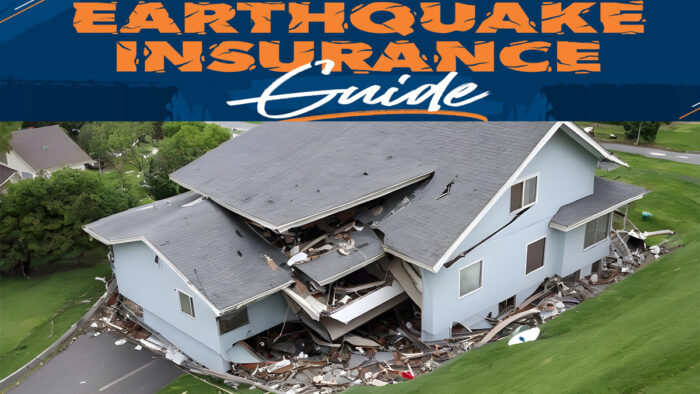Earthquake insurance covers repairs for earthquake damage to your dwelling and other structures not attached to your house, excluding pre-existing damage, external water damage, and masonry veneer in some cases.

It doesn’t cover vehicles or external water damage like floods, but may include engineering costs to stabilize the land supporting your home. Earthquake insurance is crucial, as standard policies don’t cover earthquake damage, and waiting until after an earthquake to buy insurance is not advisable due to potential coverage limitations and higher premiums.
Deductibles for earthquake coverage are typically a percentage of the replacement value of the structure, ranging from 2% to 20%, with costs varying by location, insurer, and structure type.
Retrofitting homes can reduce premiums, and it’s essential to assess the need for earthquake insurance based on your risk exposure and financial ability to recover from earthquake-related damages.
What Does Earthquake Insurance Cover?
Earthquake insurance provides coverage for various aspects in the event of an earthquake. It typically includes repairs to your house and attached structures like a garage, damaged belongings such as furniture and clothes, and additional living expenses like hotel bills if you cannot reside in your home during repairs.
Additionally, earthquake insurance may cover detached structures like carports or tool sheds, debris removal, emergency repairs to protect your home from further damage, building code upgrades to enhance safety standards, and land restoration to stabilize the property beneath your home.
However, it’s important to note that earthquake insurance usually does not cover fires caused by earthquakes, vehicle damage (covered by comprehensive auto insurance), floods (requiring separate flood insurance), sinkholes, masonry veneer, preexisting damage, or certain items like vehicles, fences, pools, and collectibles in your home.
Understanding the coverage and exclusions of earthquake insurance is crucial for homeowners in earthquake-prone areas to ensure adequate protection against potential damages.
What’s Not Covered by Earthquake Insurance?
Earthquake insurance typically does not cover certain items and damages, including fires caused by earthquakes (covered by homeowners, renters, or condo policies), vehicle damage (covered by comprehensive auto insurance), floods (requiring separate flood insurance), sinkholes, masonry veneer, preexisting damage, and external water damage like flooding or tsunamis.
Additionally, earthquake insurance may exclude coverage for specific items such as vehicles, fences, pools, collectibles in your home, and damage to the land like landscaping.
It’s important to note that earthquake insurance policies often come with high deductibles, which can range from 2.5% to 25% of the coverage limits, and choosing higher deductibles can impact out-of-pocket expenses after an earthquake.
Understanding what is not covered by earthquake insurance is crucial for homeowners to assess their risk exposure accurately and consider additional insurance options to ensure comprehensive protection against various types of damages.
Do I Need Earthquake Coverage?
Earthquake insurance is essential for homeowners, especially in earthquake-prone areas, as standard homeowners or renters insurance policies do not cover earthquake damage.
Considering the potential financial burden of rebuilding your home and replacing personal belongings after an earthquake, earthquake coverage becomes crucial for ensuring adequate protection against unforeseen damages.
While earthquake coverage may come with high deductibles and costs, it provides coverage for repairs to your house, attached structures, damaged belongings, and additional living expenses during repairs, debris removal, emergency repairs, building code upgrades, and land restoration.
It’s important to note that earthquake insurance typically does not cover fires caused by earthquakes, vehicle damage (covered by comprehensive auto insurance), floods (requiring separate flood insurance), sinkholes, masonry veneer, preexisting damage, or certain items like vehicles, fences, pools, and collectibles in your home.
Assessing the need for earthquake coveragebased on your location’s risk exposure is crucial for homeowners to ensure comprehensive financial protection against potential earthquake-related damages.
How Much Earthquake Insurance Do I Need?
When determining how much earthquake coverage you need, consider factors like your home’s location, age, construction type, rebuilding cost, and deductible preference. Rates vary based on earthquake risk, with homeowners in high-risk areas paying more.
For instance, those in low-risk areas might pay around $300 annually, while older homes in high-risk zones could face costs of up to $2,000 per year. Earthquake coverage deductibles are typically 10% to 25% of the dwelling policy limit, impacting your out-of-pocket expenses in case of a claim.
Choosing a higher deductible can lower premiums but increase what you pay upfront. Assess your ability to cover potential repair costs post-earthquake, and remember that standard homeowners insurance does not cover earthquake damage, making earthquake insurance crucial for financial protection against seismic events.
How Much Does Earthquake Insurance Cost?
The cost of earthquake coverage can vary depending on factors like your location, home’s age, construction type, proximity to fault lines, and the cost of rebuilding your home. On average, earthquake coverage in the U.S. costs around $800 per year but can exceed $2,000 in high-risk areas like California.
The deductible for earthquake insurance policies typically ranges from 10% to 25% of the coverage limit, impacting your out-of-pocket expenses in case of a claim. Factors influencing the cost include property age, location, construction materials, distance to fault lines, and rebuilding costs.
Residents of California can use the California Earthquake Authority’s premium calculator to estimate costs based on their specific needs and location. Shopping around for coverage, comparing rates from different providers, and considering seismic retrofitting to strengthen your home against earthquakes can help lower insurance costs.
What to do After an Earthquake
After an earthquake, it’s crucial to take immediate action to ensure safety and mitigate further risks. Here are the essential steps to follow:
- Check for Injuries: Assess yourself and others for injuries and provide first aid as needed.
- Inspect Utilities: Check water, gas, and electric lines for damage. If there are leaks or damage, shut off the valves and report gas smells to authorities.
- Assess Structural Damage: Examine your home for cracks, damage to the roof, and foundation. Avoid entering damaged buildings.
- Document Damage: Take photos of any damage to your property or belongings for insurance claims.
- Stay Informed: Listen to a battery-operated radio for emergency information and instructions.
- Be Prepared for Aftershocks: Expect aftershocks and practice safety measures like drop, cover, and hold on.
- Avoid Hazards: Stay away from beaches in case of tsunamis, wear closed-toed shoes around debris, and be cautious of falling objects.
- Maintain Communication: Keep an updated list of emergency contacts and phone numbers for communication.
Following these guidelines can help ensure your safety and well-being in the aftermath of an earthquake.
FAQs
Are there government programs for earthquake insurance?
In some regions, government programs like the California Earthquake Authority (CEA) offer earthquake insurance options to residents. These programs can provide coverage and assistance tailored to specific seismic risks in the area.
What factors influence the cost of earthquake coverage?
The cost of earthquake coverage is influenced by factors such as location, home construction type, proximity to fault lines, deductible amount, and the value of your property. Homes in high-risk areas or with older construction may have higher premiums.
Is earthquake coverage worth it for low-risk areas?
While seismic activity is more common in certain regions, earthquakes can occur unexpectedly in low-risk areas as well. Assessing the potential risks and considering the financial impact of earthquake damage can help determine if insurance is worth it for your location.
How can I mitigate earthquake risks without insurance?
Even without earthquake coverage, homeowners can take steps to mitigate risks by retrofitting their homes with seismic upgrades, securing heavy furniture and objects, and creating an emergency plan for family members. These measures can help reduce damage and increase safety during earthquakes.
How do I get earthquake coverage?
To get earthquake insurance, contact your current homeowners’ insurance company to inquire about adding earthquake coverage as an endorsement. If it is not available as an endorsement, you can purchase it as a standalone policy from another company. Check with your state insurance department for information on “surplus lines” companies that offer earthquake insurance.



